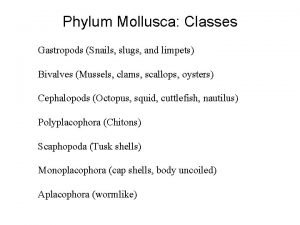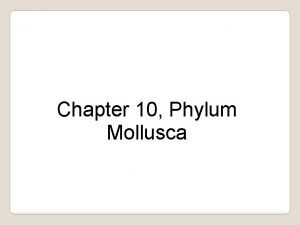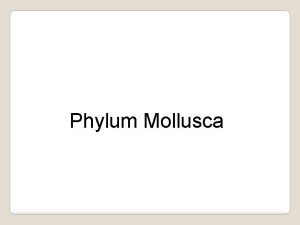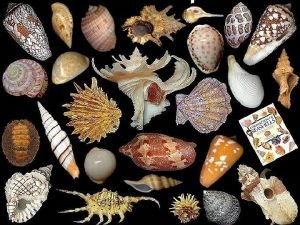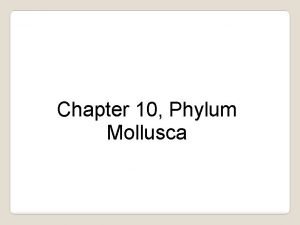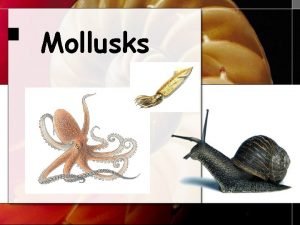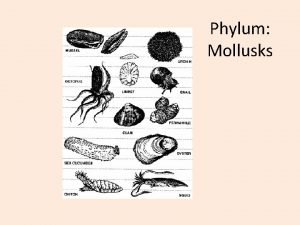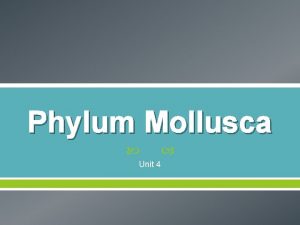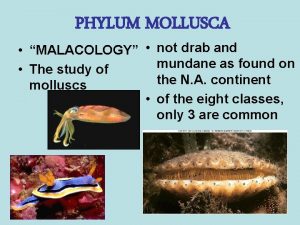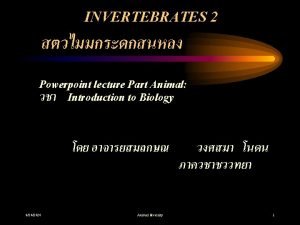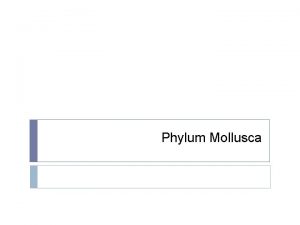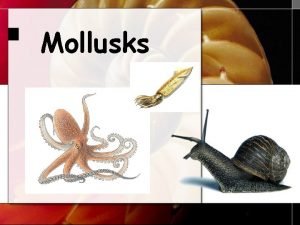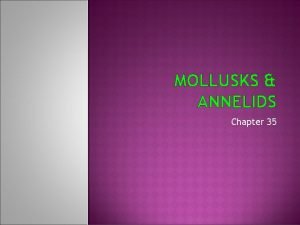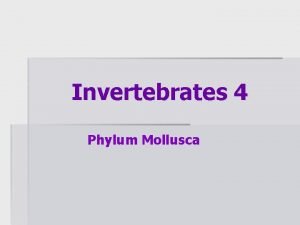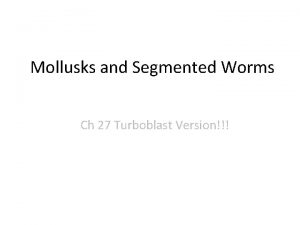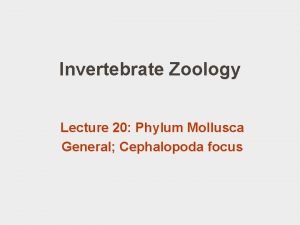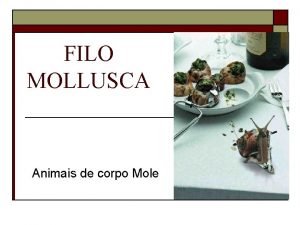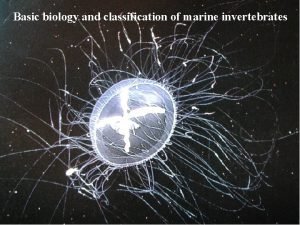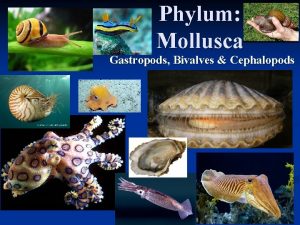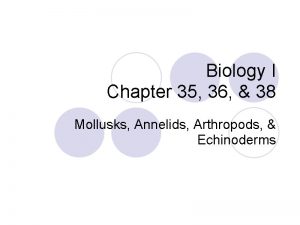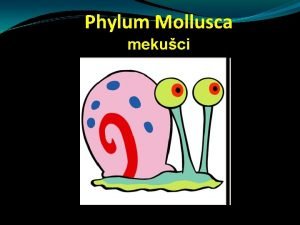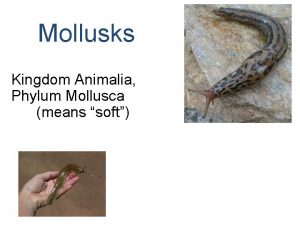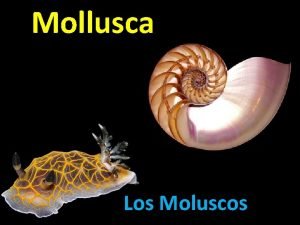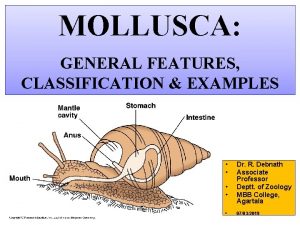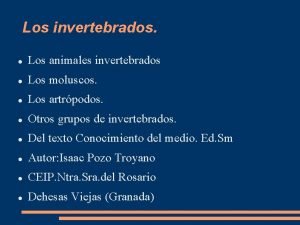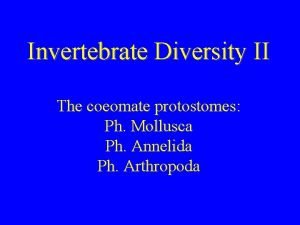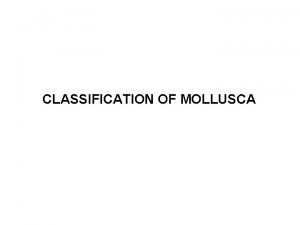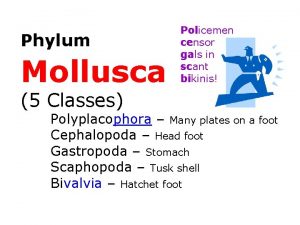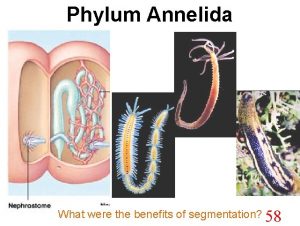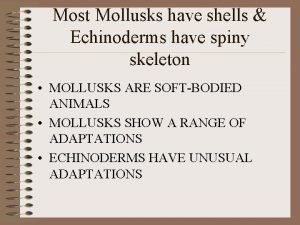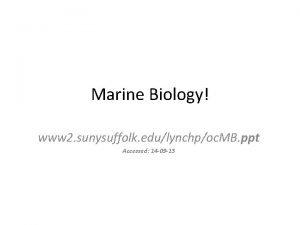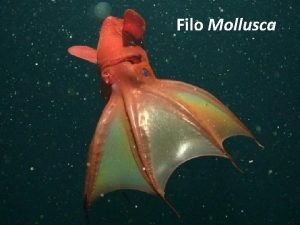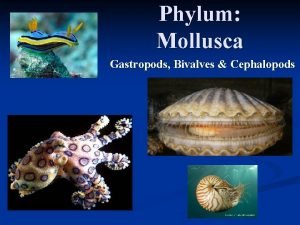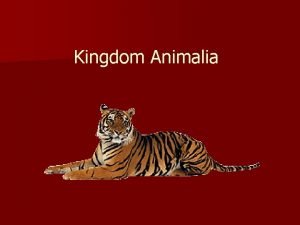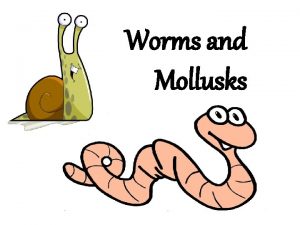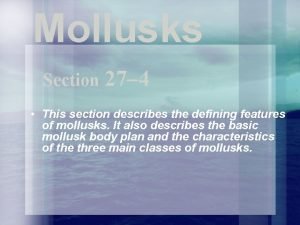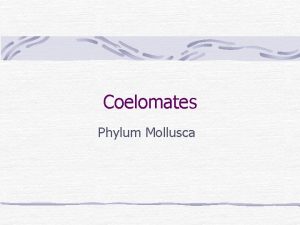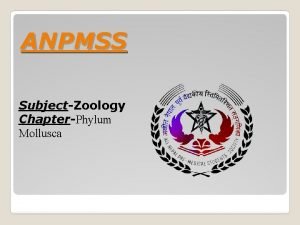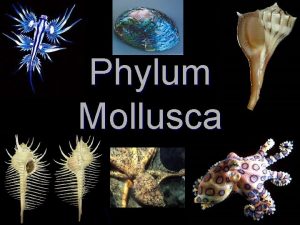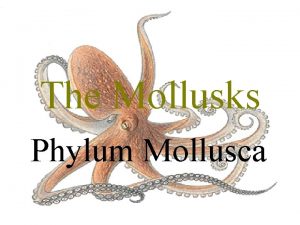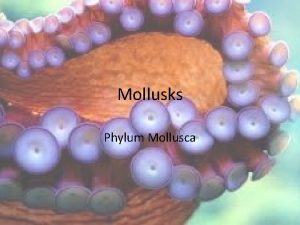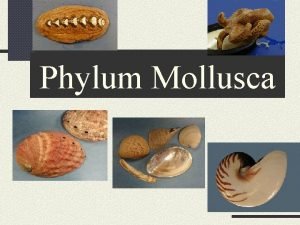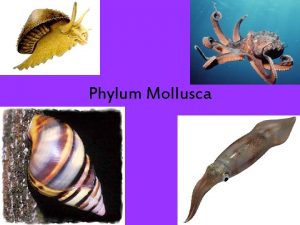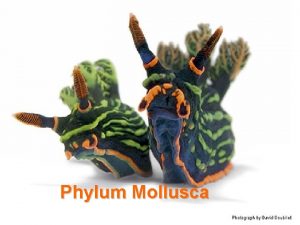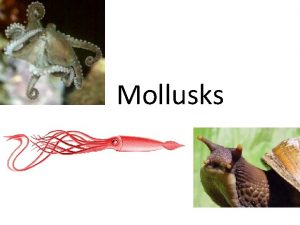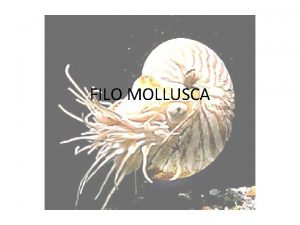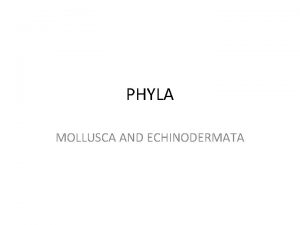Phylum Mollusca 1 Introduction to Mollusks Mollusks are




















































- Slides: 52

Phylum Mollusca 1

Introduction to Mollusks • • • Mollusks are soft-bodied animals which include snails, slugs, clams, squid and octopuses. The phylum name comes from a Latin word meaning soft There are more than 100, 000 species All mollusks share a similar 3 part body plan (foot, mantle, and visceral mass), though this has been adapted through evolution to suit many different ecological niches. Mollusks live in mostly aquatic environments (marine and freshwater). There are terrestrial species (e. g. snails, slugs) but they usually live in moist environments. 2

Unifying Traits of Phylum Mollusca All mollusks are … • Bilaterally symmetry • Not segmented • Triploblastic (three germ layers) • True coelomates, though the coelom is very reduced in many species to just a small space around the heart called a hemocoel Trochophore larva Many mollusks also produce a ciliated larval stage known as a trochophore larva. Watch this Shape of Life video introducing the mollusks: https: //www. youtube. com/watch? v=x. Kje. Jlfdc. BQ 3

Generalized Mollusk Body Plan All mollusks share the same general body plan. Some important parts are the foot (sometimes called the head-foot), the mantle, the shell, the visceral mass, and the radula. All mollusks have a foot, mantle and visceral mass. Some mollusks lack a shell and/or radula. 4

Parts of the Body Plan 1. Foot (sometimes called the headfoot) • The foot is a muscular structure • It often contains the mouth and other structures associated with feeding • There are many shapes of mollusk feet, and the shape of the foot depends on its function: • flat for crawling; • spade-shaped for burrowing; • tentacles for capturing prey 5

Parts of the Body Plan 2. Mantle • The mantle is a thin, delicate tissue layer that covers most of a mollusk’s body like a cloak. • It typically secretes the protective shell over the visceral mass. • There is usually a space between the visceral mass and the mantle known as the mantle cavity. 6

Parts of the Body Plan 3. Shell • The shell is found in almost all mollusks. Some mollusks have a very reduced shell (e. g. squid), and the octopus has lost its shell entirely. Slugs may have no shells or highly reduced internal shells. • The shell secreted by glands in the mantle. • The shell is made of calcium carbonate (Ca. CO 3). The innermost pearly layer is called nacre. • Nacre is what pearls are made of, and it is also used for mother-of-pearl jewelry. 7

Parts of the Body Plan 4. Visceral mass • The visceral mass contains the internal organs. These include organs for digestion, circulation, excretion, respiration and reproduction. 8

Parts of the Body Plan 5. Radula • The radula is a feeding structure. It is a rasping, tongue-like structure covered in teeth made of chitin. • Not all mollusks possess a radula. For example, filter feeding bivalves use their gills to filter small particles from the water column, while squid have a beak like a bird. • Mollusks who have a radula use it in different ways. Some mollusks use their radula to drill holes in shells of prey, some use it to rasp algae off rocks, and some use it to tear apart prey. 9

Bivalve Body Plan 10

Gastropod Body Plan 11

Life Processes: Feeding • There are many different types of feeding in Phylum Mollusca. • Most mollusks are herbivores (planteating), carnivores (meat-eating) or filter feeders (filter small particles and plankton from water). • A few mollusks are parasites or detritus feeders (detritus = decaying organic matter). • Many mollusks use a radula for feeding. However, bivalves use gills (filter feeders) and cephalopods use their foot (modified into tentacles) to hunt prey. 12

Life Processes: Feeding Herbivorous mollusks: • use the radula to scrape algae off rocks or plant parts 13

Life Processes: Feeding Carnivorous mollusks • Some use the radula to drill through the shells of other animals, then swallow the soft tissues inside. • Some (e. g. octopus) use foot (modified into tentacles) to grasp prey and sharp beak-like jaws to eat their prey. The radula helps tear flesh. 14

Life Processes: Feeding Filter-feeding mollusks • clams, oysters, and scallops use their gills to siphon water and sift food from the water • cilia on the gills move the mixture of mucus and food into the mouth 15

Life Processes: Feeding Mollusks possess a complete digestive tract. Food passes from mouth to stomach to intestine to anus. Digestive glands provide enzymes for digestion. 16

Life Processes: Respiration • Aquatic mollusks use their gills for gas exchange. • Terrestrial mollusks use a mantle cavity for gas exchange. • The mantle cavity must be kept moist for gas exchange • The shell often has an opening called an operculum that can seal off the shell to prevent terrestrial mollusks from drying out. 17

Aquatic mollusks use gills for respiration. 18

Life Processes: Internal Transport • The mollusk heart (or hearts) is usually located in the pericardium • Blood pumped into an open circulatory system in all mollusks except cephalopods. • (Blood is not contained in a blood vessel at all times in an open circulatory system. ) • Blood flows into sinuses where exchange occurs • Blood oxygen is carried by hemocyanin (they have blue blood!) • Cephalopods have a closed circulatory system, meaning all blood is contained in a blood vessel at all times. • Closed circulatory systems are required for fast moving animals. 19

Life Processes: Excretion Nephridia remove metabolic waste from the blood and expel it from the body. 20

Life Processes: Structure and Movement • The mollusk shell has three layers – an outer layer, a middle layer and a pearly inner layer. • Strong muscles allow for movement. • Almost all mollusks are slow moving except for cephalopods (e. g. octopus and squid) which use a siphon for jet propulsion. 21

Life Processes: Nervous System • The nervous systems of mollusks vary greatly between different classes. • Bivalves (e. g. clams, oysters, mussels) have a reduced nervous system which fits with their relatively uncomplicated, sessile lifestyles. • no brain • simple touch, balance and light receptors • Gastropods (e. g. snails, slugs) have a simple brain and simple sense organs • Cephalopods (e. g. squid, cuttlefish, octopus) have an advanced brain and advanced sense organs, including • eyes that can focus • the ability to learn and remember for long periods of time 22

Fun Fact: the brain (ganglia) of most mollusks wraps around its esophagus. 23

Life Process: Reproduction Trochophore larva • Most mollusks are dioecious and have separate sexes, but some are monoecious (hermaphroditic) • Most mollusks have external fertilization which results in a ciliated larval stage known as a trochophore larva • Cephalopods and some gastropods have internal fertilization and no trochophore larva stage • Some species of mollusks are able to switch sexes. 24

Ecologic Importance of Mollusks • Mollusks are an important food source to both humans and other animals • Oysters and some other mollusks can produce pearls and mother-of-pearl jewelry from secretions in their mantles • Bivalves (clams, oysters, etc. ) act as ecological monitors as they bioaccumulate toxins. • Bivalves also improve water quality through filter feeding, allowing light to reach aquatic autotrophs. • Some gastropods (e. g. snails and slugs) cause damage to crops • They have various medical and biochemical uses • e. g. mussels produce a natural super-glue • snails never develop cancer 25

Mollusks demonstrate divergent evolution and must have radiated out into different classes from a common ancestor. 26

There Are Seven Classes of Mollusks: • Class Aplacophora (no plates) • Class Monoplacophora (one plate) • Class Polyplacophora (many plates) • Class Scaphopoda (boat-footed) • Class Bivalvia (two valve) • Class Gastropoda (stomach-foot) • Class Cephalopoda (head-foot) 27

Class Aplacophora (No plates) • This class includes small worm-like animals • Aplacophorans lack a shell and have a simple body structure • They are found throughout the world but are exclusively marine. • They can be found very deep in the ocean, at depths of over 9000 feet. • Some species are detritivores while others are carnivores • This is a poorly understood group of mollusks that is difficult to study because they live so far underwater. 28

Class Monoplacophora (One plate) • This is an uncommon group of mollusks. Most are extinct, and a living monoplacophoran was not found until 1952. • Only 11 species are known. • The class name comes from their single plated shell. • They are all marine. • Many live very deep in the ocean. 29

Class Polyplacophora (Many plates) • This class includes the chitons. • Their shells are made up of 8 overlapping plates, and they can curl up like an armadillo. • They have a muscular ventral foot (ventral = underside of the body) for movement and to hang onto rocks. • All approximately 600 species are marine • Many live on the beach in the intertidal zone, but some live deep underwater. Most are herbivores, rasping algae off rocks with their radula. Some are predators. • Sexes are separate and fertilization is external. • Chitons are edible and were an important part of the diet of the Indigenous people of B. C. 30

There is a species of chiton called the Gumboot chiton which is nicknamed the “wandering meatloaf. ” Optional videos: • Giant. Edible. Gumboot! (Gumboot Chiton) (Waterbody): https: //www. youtube. com/wat ch? v=Sz. VVRyeo. Rv. U • Gumboot Chiton Reproduction (Joanne Green, Pender Island, B. C. ): https: //www. youtube. com/wat ch? v=zqhl 3 o. CF 96 c 31

Chiton Videos Please watch the videos in bold. The videos in italics are recommended if you have time but are ultimately optional. • “Did you know? ” Chitons (Shaw TV Victoria): https: //www. youtube. com/watch? v=Tes 14 OHKVGI • Mossy Chiton (Sea Something): https: //www. youtube. com/watch? v=r 1 i. EU 2 Kx 7 MI • Bonus Video: Facts: The Chiton (Deep Marine Scenes): https: //www. youtube. com/watch? v=Xmt. Vv. ITSUUw • Bonus Video: Sea creature makes a thousand eyes from its shell (Science Magazine): https: //www. youtube. com/watch? v=h. NDCd. IQl. Y 8 M 32

Class Scaphopoda (boat-footed) • This class includes the tusk shells. • All approximately 900 species of tusk shells are marine. They bury down into the ocean floor. • The class is named for their curved, elongated, tubular shells that open at both ends because the shells resemble the tusks of elephants. • Sexes are separate and fertilization is external, resulting in a trochophore larva. • Scaphopodans feed mainly on protists such as diatoms, which they capture with the sticky tentacles of their capatula. While it is not the most exciting video, if you really want to see them, here is a clip of them digging through a transparent agar substrate in the lab: https: //www. youtube. com/watch? v=3 N 4 j. Tfq. BTPI 33

Class Bivalvia (two valves) • This class includes many familiar shellfish such as clams, oysters, scallops and mussels. • The class name comes from their hinged shell made of two parts or valves, hence Class Bivalvia (recall bi = two) • Bivalves are all aquatic but there are both marine and freshwater species • The vast majority of bivalves are filter feeders (there a few oddball exceptions, but we will ignore them for our purposes). They lack a radula and use their gills for both gas exchange and to strain food particles from the water. • Many bivalves have a wedge-shaped foot which is good for burrowing. Mussels use their foot to secrete strong threads that anchor them to rocks. • Bivalve shellfish are an important food for humans as well as other animals. • Watch the video: Facts: Bivalves (Deep Marine Scenes): https: //www. youtube. com/watch? v=Co. Yg. Tk. DS 1 Zc 34

Bivalves: Traditional Aboriginal Clam Gardens • First Nations on B. C. ’s West Coast traditionally managed shellfish through the construction and maintenance of clam gardens. These structures increased the growth and productivity of clams on the beaches, allowing First Nations to have an increased harvest and manage the shellfish populations sustainably. • Watch the videos below to learn more about clam gardens: o A Wall Worth Building: Making Clam Habitat Great Again (Hakai Magazine): https: //www. youtube. com/watch? v=22 Nytmxw 2 Z 8 o Restoring a Coast Salish Clam Garden (Parks Canada): https: //www. youtube. com/watch? v=cv 247 v. HBll. A o Extra Bonus Video: Clam Gardens: Learning Together (Parks Canada): https: //www. youtube. com/watch? v=j 2 w. PVx 4 s. CN 0 35

Bivalve Videos: Clams Please watch the video in bold. The ones in italics are recommended but optional. • Clams vs. the World (Nat Geo Wild) https: //www. youtube. com/watch? v=_KVFDfv 6 R 2 M&list=RDQMx. EUDDg 3 n 4 Vk&index= 6 • Bonus: Giant Clams (Jonathan Bird’s Blue World): https: //www. youtube. com/watch? v=Z-32 Rf. YNb. OY • Bonus: B. C. shellfish making people sick when consumed raw (CTV News): https: //www. youtube. com/watch? v=W-zx. SEt. Ay 2 U • Bonus: Detailed Clam Dissection https: //www. youtube. com/watch? v=ADGku. X 8 IL 9 c 36

Geoduck, the World’s Rudest Clam • Pronounced “gooey duck”, the Pacific geoduck is a clam found right on our B. C. coast that is particularly prized by foodies. • It is often eaten raw like sashimi and apparently has a sweet taste and a crunchy texture, almost like cucumber. • Geoduck is an expensive delicacy in specialty food markets, and is particularly sought after in Asia. • Some people think geoduck is an aphrodisiac. Maybe it, umm, reminds them of something else? • Want to learn more? Here’s some bonus videos for you: • A serious video from Ocean Wise about how geoducks are harvested sustainably. You can also see them prepared and eaten fresh: https: //www. youtube. com/watch? v=Oe 2 x. JZHGl. Ik • A slightly less serious video from Buzz. Feed of people trying geoduck for the first time: https: //www. youtube. com/watch? v=Nkt 9 gw. Y 6 Xy 8 • An absolutely ridiculous song about digging geoduck clams by beloved CBC children’s performer Fred Penner: https: //www. youtube. com/watch? v=3 Jjh. Zf. J 4 dto&feature=youtu. be 37

Bivalve Videos: Mussels Please watch the videos in bold. The ones in italics are recommended but optional. The on how to stop eating mussels wrong is pretty entertaining, if you have the time. • Mussels at Work: A Time Lapse Demonstration: https: //www. youtube. com/watch? v=vr. Ey. Ho 3 Su. ZI • Bivalve Anatomy (mussel dissection): https: //www. youtube. com/watch? v=C-3 Gqv. Lswc 8 • Bonus: PEI: A small province with a lot of mussel (CBC): https: //www. youtube. com/watch? v=j 2_Xy. NJFy. SY • Bonus: Don’t Move A Mussel (Invasive Zebra Mussels news clip): https: //www. youtube. com/watch? v=R 2 q 0 s. J-m. Yd 4 • Silly Bonus: The Best Way to Eat Mussels - Stop Eating it Wrong (ZAGAT): https: //www. youtube. com/watch? v=ZKMe. Rb. BUT 74 38

Bivalve Videos: Oysters The videos in italics are recommended but optional. Now you can learn how pearls are made, and also how to correctly eat oysters! • Bonus: How Do Oysters Make Pearls? (Sci. Show): https: //www. youtube. com/watch? v=t. IOSWAb. Uf 74&list=RDQMx. EUDDg 3 n 4 Vk&ind ex=24 • Bonus: Formation of a Pearl (Nat Geo Wild): https: //www. youtube. com/watch? v=m 07 Ov. PEo. R 6 g • Bonus: The Right Way to Eat Oysters – Stop Eating it Wrong (ZAGAT): https: //www. youtube. com/watch? v=OLizf. Csh-NU 39

Class Gastropoda (Stomach-foot) • Includes slugs, snails, limpets, abalone and nudibranchs. This is the largest group of mollusks, and their approximately 40, 000 species make up 80% of all mollusks. • Gastropod means “stomach-foot”, and the class is named for their muscular ventral foot which is used for crawling and locomotion. • The class includes marine, freshwater and terrestrial species. • Except for slugs (including nudibranchs), gastropods have a single spiral shell. • Their visceral mass is twisted due to torsion. While they start out bilaterally symmetrical, the adult may be asymmetrical. • Most gastropods have a head with eyes and 1 -2 pairs of sensory tentacles. • Many gastropods feed with a rasping radula. The class includes both herbivores and carnivores. Some snails and slugs are pest species for human food crops. • Aquatic species use gills for respiration; terrestrial species use primitive lungs. • Gastropods may be hermaphroditic or dioecious depending on the species. 40

Gastropod Videos: Snails. While I bet you can picture a familiar terrestrial one, others might be less familiar. See those holes in the shells up at the top? The carnivorous marine moon snail on the right used its radula to drill through so it could dine in style on the clam inside. Other species of snails are herbivores, like the one I caught in my garden munching my plants recently. Please watch the videos in bold. The ones in italics are recommended but optional. (But don’t you want to learn how to eat escargot correctly? ) • Microworlds – The Secret Life of the Snail (Love Nature): https: //www. youtube. com/watch? v=KD 2 m 6 H 3 Rb 18 • Deep Look: Everything You Never Wanted to Know About Snail Sex: https: //www. youtube. com/watch? v=UOc. La. I 44 TXA&list=RDQMx. EUDDg 3 n 4 Vk&index=22 • Bonus: Moon snail, egg casings, and shells it drilled: https: //www. youtube. com/watch? v=m 94 IXEAK_3 Q • Bonus: Moon snail gets dinner: https: //www. youtube. com/watch? v=u. FXda. QREa. UA • Bonus: Moon Snail in Puget Sound Seattle: https: //www. youtube. com/watch? v=G 8 KZw. B 6 l 8 Dw • Bonus: The Right Way to Eat Escargot aka Whole Snails – Stop Eating it Wrong (Zagat): https: //www. youtube. com/watch? v=Yvy 71 v 4 x 55 s • Bonus: Deep Look: Watch These Cunning Snails Stab and Swallow Fish Whole: https: //www. youtube. com/watch? v=j. YMj. Lg. PFSso 41

Gastropod Videos: Limpets are a type of aquatic herbivorous snail with cone-shaped shells. They are common in the rocky intertidal zones of B. C. ’s beaches. They can use their muscular feet to hold on very tight to rocks, making it hard to pull them off. Limpets are edible but can be rubbery in texture if overcooked. Please watch the videos in bold. The ones in italics are recommended but optional. • Limpets Grazing (The Marine Biological Association): https: //www. youtube. com/watch? v=Z_6 CE 62 L 2 b. U • Limpet Fights off a starfish (BBC): https: //www. youtube. com/watch? v=vd 7 Kk. AKSIi. A 42

Gastropod Videos: Abalone are another type of marine snail found in B. C. Abalone feed on kelp, but if kelp forests are destroyed by an overabundance of sea urchins, abalone can starve. Abalone are edible and were an important food source for First Nations in B. C. The nacre of the interior of their shells isalso particularly beautiful. Unfortunately, the Northern Abalone is endangered. All harvest of abalone in B. C. is prohibited, but poaching is still a problem. Please watch the videos in bold. The ones in italics are recommended but optional. • DYK Abalone – Shaw TV Victoria: https: //www. youtube. com/watch? v=l. Aya 00 is 9_w • Bonus: Facts: The Abalone (Deep Marine Scenes): https: //www. youtube. com/watch? v=A 2 M 1 y. Km_x 1 M • Bonus: Learn about the endangered northern abalone and how marine biologists are researching their populations to protect them. The Northern Abalone in Haida Gwaii (Haida Gwaii Marine Stewardship Group): https: //www. youtube. com/watch? v=QCvmc. U 1 gr. Fk 43

Gastropod Videos: Slugs Are slugs just snails without shells? And what the heck is a semislug? Luckily, the first video in the playlist will answer both of those questions for you! (Also, I really love how much that guy loves his job. ) Please watch the videos in bold. The ones in italics are recommended but optional. • Ask A Scientist – Are Slugs Just Snails with their Shells Taken Off? (Carnegie Museum of Natural History): https: //www. youtube. com/watch? v=LSMta. F 6 BA 9 E • Deep Look: Banana Slugs: Secret of the Slime: https: //www. youtube. com/watch? v=m. Hv. CQSGan. Jg&list=RDQMx. EUDDg 3 n 4 Vk&index=24 • Bonus: Amazing High Speed Slug: Timelapse https: //www. youtube. com/watch? v=TYVJow. Ote. O 0 44

Gastropod Videos: Nudibranchs Okay, there is absolutely no contest. The coolest slugs ever are nudibranchs. And before you ask, all nudibranchs are sea slugs, but not all sea slugs are nudibranchs. (What? You weren’t going to ask that? Weird. ) Let’s put aside their confusing taxonomy for a second and focus on the coolest thing about them: they steal nematocysts from cnidarians! Please watch the videos in bold. The ones in italics are recommended but optional. • Deep Look: This Adorable Sea Slug is a Sneaky Little Thief (Nudibranchs): https: //www. youtube. com/watch? v=KLVf. WKxtfow • Jonathan Bird’s Blue World: Nudibranchs: https: //www. youtube. com/watch? v=i. MGhu. GOn. Y 24 • Bonus: Sea Slugs are like Real-life Po. Kemon (Animalogic): https: //www. youtube. com/watch? v=3 Sgvl. Qyr. JBU 45

Class Cephalopoda (Head-foot) • This class includes nautilus, squid, octopus and cuttlefish. • The cephalod’s foot is modified into tentacles for feeding. • Of the cephalopods, only the nautilus has a shell; other species have traded protection for agility and speed. • Cephalopods use their mantles for jet propulsion by drawing in water and then expelling it rapidly through a siphon. • Cephalopods are active predators with closed circulatory systems and well-developed nervous systems. They have beak-like jaws, almost like a parrot’s, which can bite and tear flesh. • Watch this video introducing the cephalopods: Super Suckers: Cephalopods! (Jonathan Bird’s Blue World): https: //www. youtube. com/watch? v=r. Zw. V 0 PCW 2 w 8&t=4 s 46

Cephalopod Videos: Nautilus The nautilus is a bit of an anomaly among the cephalopods because it is the only one which has hung on to an external shell. It can fill the chambers of its shell with gas to change its buoyancy. Nautiluses have looked the same for millions and millions of years. Please watch the videos in bold. The ones in italics are recommended but optional. • How is a nautilus different from a squid? (American Museum of Natural History): https: //www. youtube. com/watch? v=NLfk 6 U 0 ei. FE • Teaching Ancient Nautilus New Tricks (Sci. Fri): https: //www. youtube. com/watch? v=PIhe. RYcm 6 s. I • Bonus: The nautilus will make you rethink intelligence (Popular Science): https: //www. youtube. com/watch? v=5 UYFCi. V 0 r 4 c • Bonus: Chambered Nautilus Are Hatching At The Aquarium (Monterey Bay Aquarium): https: //www. youtube. com/watch? v=JPZ 4 a 6 QJ 84 s • Bonus: Absurd Creatures – The Curious Case of the Elusive, Slimy Nautilus (Wired): https: //www. youtube. com/watch? v=x. Jpq. U 8 CFT-s • Bonus: Nautilus Feeding (Shedd Aquarium): https: //www. youtube. com/watch? v=h. XPEH_ws. ZBM 47

Cephalopod Videos: Squid Please watch the videos in bold. The ones in italics are recommended but optional. • How the Squid Lost Its Shell (PBS Eons): https: //www. youtube. com/watch? v=S 4 vxo. P-IF 2 M • You’re Not Hallucinating. That’s Just Squid Skin (Deep Look): https: //www. youtube. com/watch? v=0 wt. Lrl. IKv. JE&list=RDQMx. EUDDg 3 n 4 Vk&index=10 • Bonus: The Origin of the Kraken (Animalogic): https: //www. youtube. com/watch? v=k. Apzlh. DB-28 • Bonus: How squid outsmart their predators (Ted-Ed): https: //www. youtube. com/watch? v=cp. Jl. Qo_65 Ko&list=RDQMx. EUDDg 3 n 4 Vk&index=26 • Bonus: Diver Pulled Under by Squids – Man-Eating Super Squids (Animal Planet): https: //www. youtube. com/watch? v=Ml. RA 5 TMPWZ 4&list=RDQMx. EUDDg 3 n 4 Vk&index=20 48

Cephalopod Videos: Squid Dissection Please watch the videos in bold. The ones in italics are recommended but optional. • A proper squid dissection by someone who actually knows what they’re talking about: https: //www. youtube. com/watch? v=Oue. Q 9 k. U 36 i 0 • Bonus: Turns out that cleaning squid is just a very specific type of dissection done by people who don’t know the right words for squid parts but do know how to prepare them to be tasty! How to clean squid (Bart’s Fish Tales): https: //www. youtube. com/watch? v=Zf 0 Bv. XTvahg Glossary for the video above: tentacles (yeah, 8 of those were actually arms. Only two were tentacles!), “bony piece” (beak), “body tube” (mantle), “very thin piece of plastic” (pen), “wing” (fin). Oh well … he tried. I’ll forgive him if he makes me calamari. • Extra bonus: If you want to learn absolutely nothing about squid anatomy but you do want to see Gordon Ramsay yell at people on Hell’s Kitchen for not cleaning them correctly, watch this one: https: //www. youtube. com/watch? v=DRYeh 9 x. VMqg 49

Cephalopod Videos: Octopuses are so awesome! I have chosen three great videos that I’d like you to watch that give you a good intro, but the next slide has a whole bunch of videos on them if you want to do a really deep dive into the world of octopuses. Please watch the videos in bold. The ones in italics are recommended but optional. • Octopuses 101 (Nat Geo Wild): https: //www. youtube. com/watch? v=o. Sy. EZAm 8 nb 8 • Octopuses are the World’s Greatest Escape Artists (Animalogic): https: //www. youtube. com/watch? v=w. Sn 7 CJ 0 c. NZ 4 • Octopuses Are Ridiculously Smart (Sci. Show): https: //www. youtube. com/watch? v=JOVDlx. Ti. FU&list=RDQMx. EUDDg 3 n 4 Vk&index=23 50

Cephalopod Videos: Octopuses (Bonus) • Bonus: Why the octopus brain is so extraordinary (TED-Ed): https: //www. youtube. com/watch? v=VLk. Ki. VIBx. XU&list=RDQMx. EUDDg 3 n 4 Vk&index=29 • Bonus: If Your Hands Could Smell, You’d Be an Octopus (Deep Look): https: //www. youtube. com/watch? v=XXMxih. Oh 8 ps&list=RDQMx. EUDDg 3 n 4 Vk&index=27 • Bonus: Coconut Octopus Uses Tools to Snatch a Crab (Smithsonian Channel): https: //www. youtube. com/watch? v=BFda 1 MZ 54 G 4 • Bonus: Mimic Octopus: Master of Disguise (Getty Images TV): https: //www. youtube. com/watch? v=Wos 8 kouz 810 • Bonus: The Mimic Octopus: Nick Baker’s Weird Creatures (Discovery UK): https: //www. youtube. com/watch? v=3 kr. N 7 vi 5 tlc • Bonus: Giant Pacific Octopus Adventure (Jonathan Bird’s Blue World): https: //www. youtube. com/watch? v=BZpx. Do_6 -r. A • Bonus: My Date With A Giant Pacific Octopus (It’s Okay To Be Smart): https: //www. youtube. com/watch? v=F_JNRpbq. Jtk • Bonus: Diver Gets Totally Engulfed by Giant Pacific Octopus (Port Hardy, BC): https: //www. youtube. com/watch? v=hmnaoa 7 n 4 o. U 51

Cephalopod Videos: Cuttlefish Okay, I left my favourite for last. The cuttlefish might be tied with nudibranchs for my favourite mollusk. These guys are crazy cool! They hypnotize their prey with dazzling light shows they put on with their chromatophores. I’m so sad we don’t have any local species. Please watch the videos in bold. The ones in italics are recommended but optional. • Cuttlefish use Hypnosis to Hunt (Animalogic): https: //www. youtube. com/watch? v=4 IDCpz 7 b. Y 6 I (Feel free to stop just after 7: 00 when she starts talking about math and the site that sponsored the video. There’s no relevant content after this point. ) • Bonus: Cuttlefish: Disco Camouflage Chameleons of the Sea (It’s Okay To Be Smart): https: //www. youtube. com/watch? v=lcwf. TOg 5 rnc • Bonus: Caring for Cuttlefish (Sci. Fri): https: //www. youtube. com/watch? v=WPFCFGB 5 IHA • Bonus: Cuttlefish Camouflage (The New York Times): https: //www. youtube. com/watch? v=m. W 4 Pb. W 893 ik • Bonus: Kisslip Cuttlefish Changing Colours in Inkcredible Mating Displays! (Monterey Bay Aquarium): https: //www. youtube. com/watch? v=WOBz. OPDV 8 Ho 52
 Antigentest åre
Antigentest åre Limpets phylum
Limpets phylum Mollusca open circulatory system
Mollusca open circulatory system Phylum mollusca homework and study guide #1
Phylum mollusca homework and study guide #1 Phylum mollusca characteristics
Phylum mollusca characteristics Hewan filum mollusca
Hewan filum mollusca Characteristics of phylum mollusca
Characteristics of phylum mollusca General characteristics of phylum mollusca
General characteristics of phylum mollusca Example of molluscs
Example of molluscs 3 classes of mollusca
3 classes of mollusca Introduction of mollusca
Introduction of mollusca Mollusca introduction
Mollusca introduction Bivalvia phylum
Bivalvia phylum Mollusca
Mollusca Mollusca examples with names
Mollusca examples with names Mollusca body plan
Mollusca body plan Peristaltic movement
Peristaltic movement Ham mollusca
Ham mollusca Segmentation in mollusca
Segmentation in mollusca Mollusca class
Mollusca class Mollusca
Mollusca Simetria mollusca
Simetria mollusca Crustaea
Crustaea Invertebrates characteristics
Invertebrates characteristics Mollusca body plan
Mollusca body plan Mollusca segmentation
Mollusca segmentation Conch phylum
Conch phylum Mollusca annelida arthropoda
Mollusca annelida arthropoda Osfradije
Osfradije Echinodermata endoskeleton
Echinodermata endoskeleton Animalia mollusca
Animalia mollusca Endoskeleton mollusca
Endoskeleton mollusca Are mollusks bilateral symmetry
Are mollusks bilateral symmetry Moluscos
Moluscos Mollusca
Mollusca Invertebrado que tiene el cuerpo cubierto de poros
Invertebrado que tiene el cuerpo cubierto de poros Trochophore phylum
Trochophore phylum Deuterostomes vs protostomes
Deuterostomes vs protostomes Oxyconformer
Oxyconformer Neopilina belongs to
Neopilina belongs to Are mollusca bilateral symmetry
Are mollusca bilateral symmetry Umbo mollusca
Umbo mollusca Mollusca segmentation
Mollusca segmentation Mollusca skeletal system
Mollusca skeletal system Charneira moluscos
Charneira moluscos Mollusca
Mollusca Ametaméricos
Ametaméricos Quitons
Quitons Mollusca
Mollusca Mollusca
Mollusca Exoskeletonn
Exoskeletonn Characteristics of a worm
Characteristics of a worm Section 27-1 flatworms
Section 27-1 flatworms

